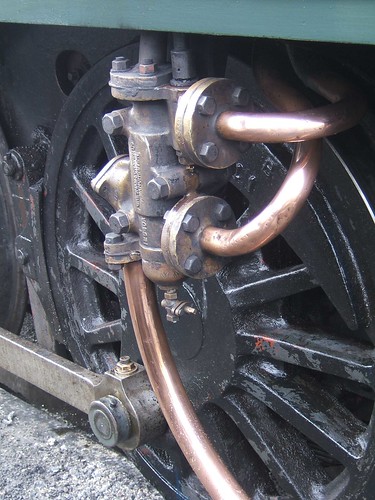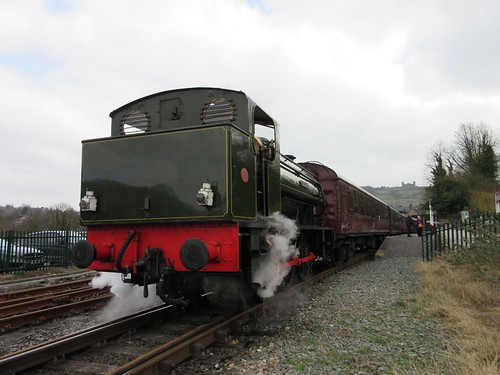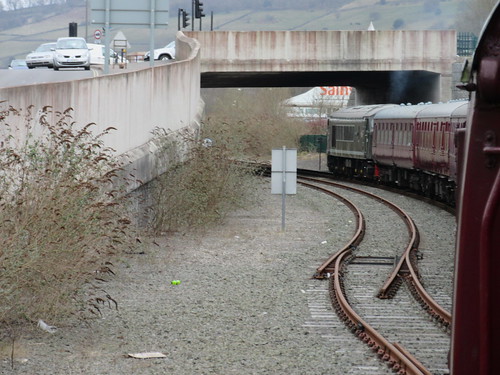'Lord Phil' certainly looked the part, standing on the outside pit in clean condition with plenty of polished brass on display and 'brewing up' nicely. However my priority was to oil round and carry out the daily exam. That meant the usual exercise of applying 'motion oil' to the six crankpins, the various oil boxes and oil pots, leaning in between the frames to reach the oil cups and oil holes on the motion. This usually involves climbing up onto the foot framing, dealing with the accessible oiling points, then climbing down to the ground and up again in various positions until most oil points are dealt with, leaving perhaps a few locations to be reached whilst in the pit underneath the locomotive whilst at the same time inspecting springs, motion and, well, everything.

Fireman's side Injector on an 'Austerity' ('Royal Pioneer').

Fireman's side Combined Steam and Delivery Valve and 'Klinger' Gauge Frame on an 'Austerity' ('Royal Pioneer').
There's a PDF of the Davies and Metcalfe publication 'Monitor Type Locomotive Live Steam Injector' here which will repay careful study. Relevant to 'Lord Phil' are the Combined Steam and Delivery Valve (on page 20) and the Non-Lifting Live Steam Injector 'Austerity' type (shown on page 22).
Dave knew there had been problems previously with the fireman's side injector failing to shut off properly after use resulting in steam and/or water discharging from the overflow pipe. The injector on the driver's side wasn't much better but we agreed to see how things went during the first Driving Experience course. When people are looking forward to a driving experience, may have travelled a considerable distance and, often, incurred accommodation costs, I hate to disappoint them, but, of course, safety is always the top priority. I do remember having to declare a failure on 'Royal Pioneer' when the regulator linkage in the steam dome became detached - that's described here.
We were having serious trouble with loss of water but we managed to complete the two driving experience courses and then attempted to water before the first service train, using the brown water tank at the south end of the platform only to discover that the brown tank wagon was out of water. I discussed with Gordon the easiest solution and we agreed to swop the engines round, with 'Penyghent' on the south end and 'Lord Phil' on the north end. This meant that we could reach the Grey water tank at the north end of the platform which is currently little-used. The grey water tank is much easier to use (provided you stop in the right place), because, instead of dragging a long fire hose around, there is just a hinged delivery pipe which swings across to the tank filler. This also gave a bit of variety in that we hauled the train uphill, rather than downhill, and did so bunker-first.
 'Lord Phil' at Matlock, ready to haul the service train back to Rowsley.
'Lord Phil' at Matlock, ready to haul the service train back to Rowsley.
Neither Dave nor I thought the arrangements ideal but we managed to run the service all day. One or two people enquired about the locomotives being the opposite way round to normal.
 Peak Rail: 'Penyghent', unusually on the south end of the train, approaches Matlock, viewed from 'Lord Phil' on the north end.
Peak Rail: 'Penyghent', unusually on the south end of the train, approaches Matlock, viewed from 'Lord Phil' on the north end.
I think this was Penyghent's 'swan song' before being taken 'Out of Traffic' for a major overhaul.
My pictures
Peak Rail 2015.
